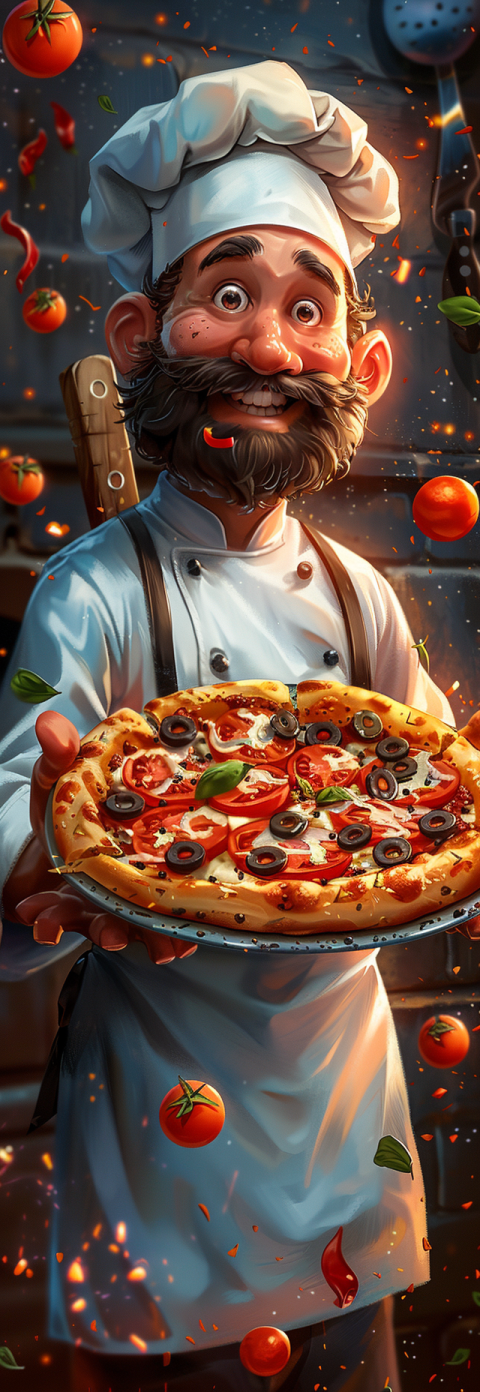











Pizza: A Global Food Phenomenon - From Humble Beginnings to Culinary Icon
Pizza, a dish of Italian origin consisting of a flattened base of dough topped with various ingredients and baked, has become a global food phenomenon. Its simple yet satisfying combination of bread, sauce, cheese, and toppings has made it one of the most popular and recognizable foods worldwide. From its humble beginnings in Naples to its countless variations across cultures, pizza has a rich history and continues to evolve, reflecting local tastes and culinary innovation.
1. The Early History of Pizza: Flatbreads with Toppings
The concept of pizza can be traced back to ancient civilizations:
- Ancient Greeks, Romans, and Egyptians consumed flatbreads with various toppings.
- The word "pizza" was first documented in Gaeta, Italy, in 997 AD. It is thought to be derived from the Latin word "pinsa" which means flatbread.
- These early pizzas were likely simple flatbreads topped with herbs, garlic, and other readily available ingredients.
2. The Birth of Modern Pizza: Naples, Italy
The modern pizza as we know it originated in Naples, Italy:
- In the 18th and 19th centuries, Naples was a bustling port city with a large working-class population.
- Street vendors sold large flatbreads topped with simple, affordable ingredients like tomatoes, garlic, and cheese to the city's poor.
- Pizza became a popular and inexpensive food, providing a quick and satisfying meal.
- Pizza Margherita, a pizza topped with tomatoes, mozzarella cheese, and basil, representing the colors of the Italian flag, was allegedly created in 1889 in honor of Queen Margherita of Savoy.
3. Pizza's Journey to America: From Italian Immigrants to Mainstream Popularity
Pizza was brought to the United States by Italian immigrants in the late 19th and early 20th centuries:
- The first pizzeria in the United States, Lombardi's, opened in New York City in 1905.
- Initially, pizza was primarily consumed by Italian-American communities.
- After World War II, the popularity of pizza exploded in the United States, as American soldiers returning from Italy brought back a taste for the dish.
- Pizza chains like Pizza Hut (founded in 1958) and Domino's (Pizza in 1960) played a major role in popularizing pizza across the country and eventually the world.
4. Types of Pizza: A World of Styles
Pizza has evolved into a wide variety of styles, each with its own unique characteristics:
- Neapolitan Pizza: The original style of pizza from Naples, featuring a thin, soft, and chewy crust, traditionally cooked in a wood-fired oven. It typically has a raised edge called the cornicione.
- New York-Style Pizza: Large, thin-crust pizza that is typically sold in wide slices, often folded in half to eat.
- Chicago-Style Deep-Dish Pizza: A thick pizza baked in a deep dish, with a high edge and a large amount of cheese and toppings.
- Sicilian Pizza: A thick-crust, rectangular pizza often topped with onions, anchovies, tomatoes, herbs and cheese.
- California-Style Pizza: Known for its use of fresh, unconventional toppings, often with a focus on local and seasonal ingredients.
- Detroit Style Pizza: Rectangular pizza with a thick, crispy crust. It is often baked in a well-oiled pan and topped with cheese that extends to the edges.
5. Pizza Dough: The Foundation of a Great Pizza
The dough is a crucial element of any pizza:
- Pizza dough is typically made from flour, water, yeast, salt, and sometimes olive oil.
- The type of flour used can affect the texture of the crust. Bread flour, with its higher protein content, is often preferred for pizza dough.
- The dough is kneaded to develop gluten, which gives the crust its structure and chewiness.
- Pizza dough is typically allowed to rise (ferment) before being shaped and baked.
6. Pizza Sauce: From Simple to Complex
Pizza sauce is another key component:
- Traditional Neapolitan pizza sauce is made with simple ingredients: crushed San Marzano tomatoes, garlic, oregano, and salt.
- Other styles of pizza may use more elaborate sauces, incorporating herbs, spices, onions, and other ingredients.
7. Pizza Cheese: The Essential Topping
Cheese is an essential topping for most pizzas:
- Mozzarella is the most common type of cheese used on pizza, prized for its meltability and stretchability.
- Other cheeses, such as provolone, Parmesan, ricotta, and fontina, are also used, either alone or in combination with mozzarella.
8. Pizza Toppings: Endless Possibilities
Pizza toppings offer endless possibilities for customization and flavor combinations:
- Pepperoni: The most popular pizza topping in the United States.
- Mushrooms: A classic pizza topping.
- Onions: Add a pungent flavor and aroma.
- Peppers: Bell peppers, jalapeños, and other varieties add flavor and spice.
- Sausage: Italian sausage, chorizo, and other types of sausage are popular pizza toppings.
- Olives: Black or green olives add a salty, briny flavor.
- Vegetables: A wide range of vegetables, such as spinach, broccoli, artichoke hearts, and tomatoes, can be used as pizza toppings.
- Meats: Besides pepperoni and sausage, other popular meat toppings include ham, bacon, ground beef, and chicken.
9. Pizza Around the World: Global Variations
Pizza has been adapted and reinvented in countless ways around the world:
- Italy: Besides the classic Neapolitan pizza, other regional variations include pizza al taglio (Roman pizza sold by the slice) and pizza fritta (fried pizza).
- United States: Home to numerous regional pizza styles, including New York-style, Chicago-style, and California-style.
- Brazil: Often features unconventional toppings like hearts of palm, catupiry cheese, and even sweet toppings like chocolate and bananas.
- Japan: May include toppings like corn, potatoes, mayonnaise, and seaweed.
10. The Future of Pizza
- Pizza continues to evolve, with new styles, toppings, and technologies emerging.
- Gourmet pizza and artisanal pizzerias are gaining popularity, focusing on high-quality ingredients and traditional techniques.
- Delivery and takeout options continue to make it more accessible.
Conclusion:
Pizza is a global food phenomenon that has captured the hearts and palates of people around the world. Its simple yet satisfying combination of dough, sauce, cheese, and toppings has made it a beloved food for generations. From its origins in Naples to its countless variations across cultures, pizza has a rich history and continues to evolve, reflecting local tastes and culinary innovation. Whether you prefer a classic Margherita or a more adventurous combination of toppings, pizza offers a delicious and customizable dining experience that is sure to please.
Pizza, pizza near me, pizza delivery, pizza toppings, types of pizza, pizza dough, pizza sauce, pizza cheese, pizza recipes, best pizza, pizza history, Neapolitan pizza, New York-style pizza, Chicago-style pizza, Sicilian pizza, California-style pizza, Pizza Hut, Domino's Pizza, Papa John's, Little Caesars, Lombardi's, pizza dough recipe, pizza sauce recipe, how to make pizza, order pizza online, gourmet pizza, vegetarian pizza, vegan pizza, gluten-free pizza.

